Reporting the future of mobile UX from MEX 2012
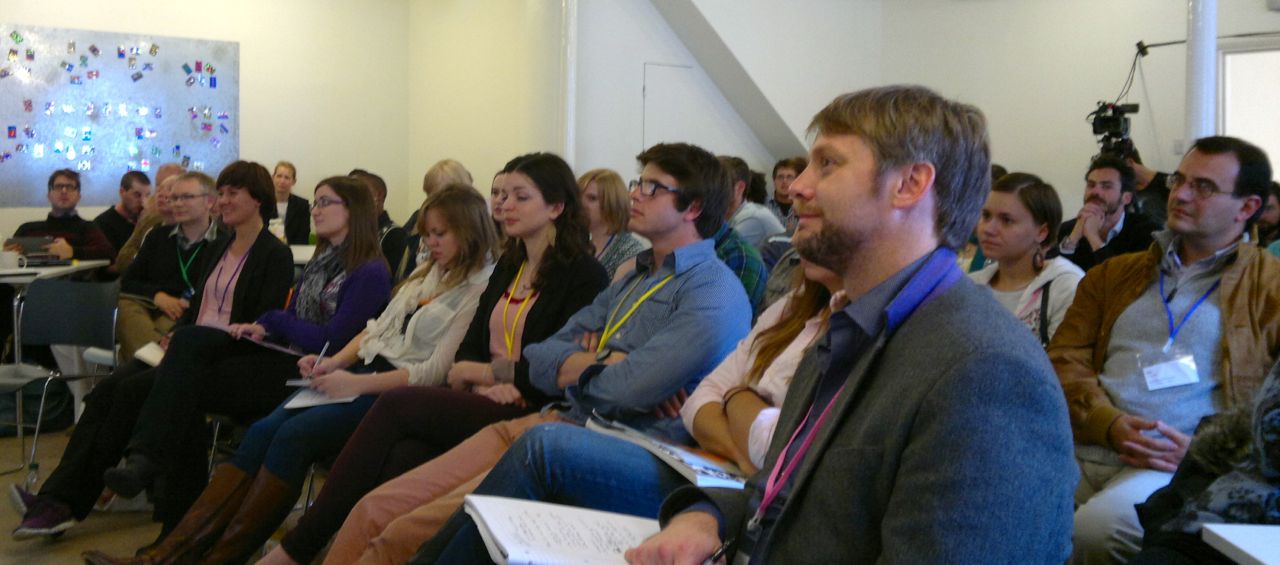
The 11th international MEX set out to define best practice and create new ideas in 6 Pathways – Diffusion, Concurrency, Sensation, Context, Clarity and Speed – each focused on a specific aspect of mobile user experience.
Exploration of these Pathways began some months before in essays and conversations among the MEX community. The 19th – 20th September event in London was the focal point for participants from 11 different countries to expand these discussions.

Upon arrival everyone received a 26 page book containing 6 MEX essays, one for each of the Pathways, to debate and digest over breakfast in the venue’s garden cafe.
The co-hosts of MEX, Andrew Muir Wood and Marek Pawlowski, opened by encouraging participants to seize upon MEX as an opportunity for exploring tangents beyond their day-to-day professions. Andrew and Marek explained how the Pathways formed and shared examples of how each might develop.

Marek described how Pathway #2, Diffusion, formed from observational research: noticing the proliferation of digital touchpoints in users’ lives and how experiences were expanding beyond the constraints of individual devices. He cited Sherry Turkle’s work at MIT and her book ‘Alone Together‘, identifying changing social behaviour where users, even close family members, sit together, but disconnected from each other. They are instead absorbed through digital devices in their own virtual worlds. He went on to identify the correlation between declining face to face human interaction and a rise in machine to machine communication. Nokia’s recent product launches, where ‘touch to’ NFC functionality was at the heart of its device and accessory strategy, were evidence of machines finding their voices.
He identified the challenge at the heart of this Pathway, saying: “Designers of digital experiences are adapting to a new world, where the implicit guarantee of singular attention that once accompanied the use of digital products is no longer there.”
Andrew connected this theme with Pathway #14, Context, showing a voice recognition system struggling with the subtleties of name pronunciation. He warned the technical possibility of context aware experiences was tantalising, but early benchmarks such as the infamous Microsoft Clippy assistant meant users remained skeptical.
He identified priorities for delivering the promise of contextually responsive experiences, including judging when to make contextual suggestions and reassuring nervous users by explicitly committing to transparency. Andrew highlighted SmartThings, a Kickstarter-funded home automation system, as an example of how a balanced level of user control could create a successful contextual experience.
Marek introduced Pathway #3, Concurrency, as a methodology to place human to human interaction back at the heart of digital experiences. He pointed to observations of users’ instinctive desire to interact with the same device simultaneously, such as people gathered around a single iPad on a coffee shop table.
This innate behaviour challenged designers to create interfaces suited to simultaneous, multi-person usage. Digital interface design is currently based around the opposite principle, assuming a single user at any one time. Simultaneous multi-person user interfaces (SMUIs) bring users closer together and employ digital interactions to augment, rather than distract, from human to human conversations.
He showed an example by Kate Ho’s Tiger Face games, Equator Trailer, where children and adults interacted with the same game at the same time on a single iPad.
Pathway #9, Sensation, explores multi-sensory interfaces beyond visual design. Andrew identified the dominant trend in mobile: one dimensional experiences almost entirely created through visual interactions, pointing to the disproportionate attention Apple dedicated to the screen during its iPhone 5 launch.
He showed examples of user research from ‘Curious Rituals‘ by Nicolas Nova, a book cataloguing unusual behaviours emerging in a display-dominated world. These included ‘constant checker’, with head permanently bobbing to check their device, to ‘iPad periscope’, where users frames their world through the viewfinder of an unfeasibly large tablet.
Andrew asked if there was a better way to communicate with users and played an audio clip of a modem dial-up sound to remind participants how evocative non-visual sensations like sound and haptic feedback could be.
Pathway #16 looks at perception of speed. Marek explained designers needed to think beyond metrics such as megahertz and processor cores. He used a broad example, reminding participants that 5 years ago it took him 41 minutes to watch a new video at home, counting the time taken to drive to the video shop, pay, drive back and load the DVD player. Today’s user experience is 82x faster with services like Apple TV, where videos take 30 seconds to load.
However, he cautioned against speed as a universal goal, reminding participants slow could be beautiful too, as a slow motion video recorded at 2500 frames per second unfolded on the screen behind him.
Andrew picked up on this theme of detail in Pathway #15, Clarity, looking at the transformative potential of increased pixel density. As he spoke, the screen expanded through successive generations of mobile display, from a tiny postage-stamp sized block of colour, equivalent to what would have been visible on the 101 x 80 pixel display of the Sony Ericsson T68i in 2002, to gradually reveal the full MEX 2012 signature image, as it would be seen on a 2048 x 1536 iPad 3.
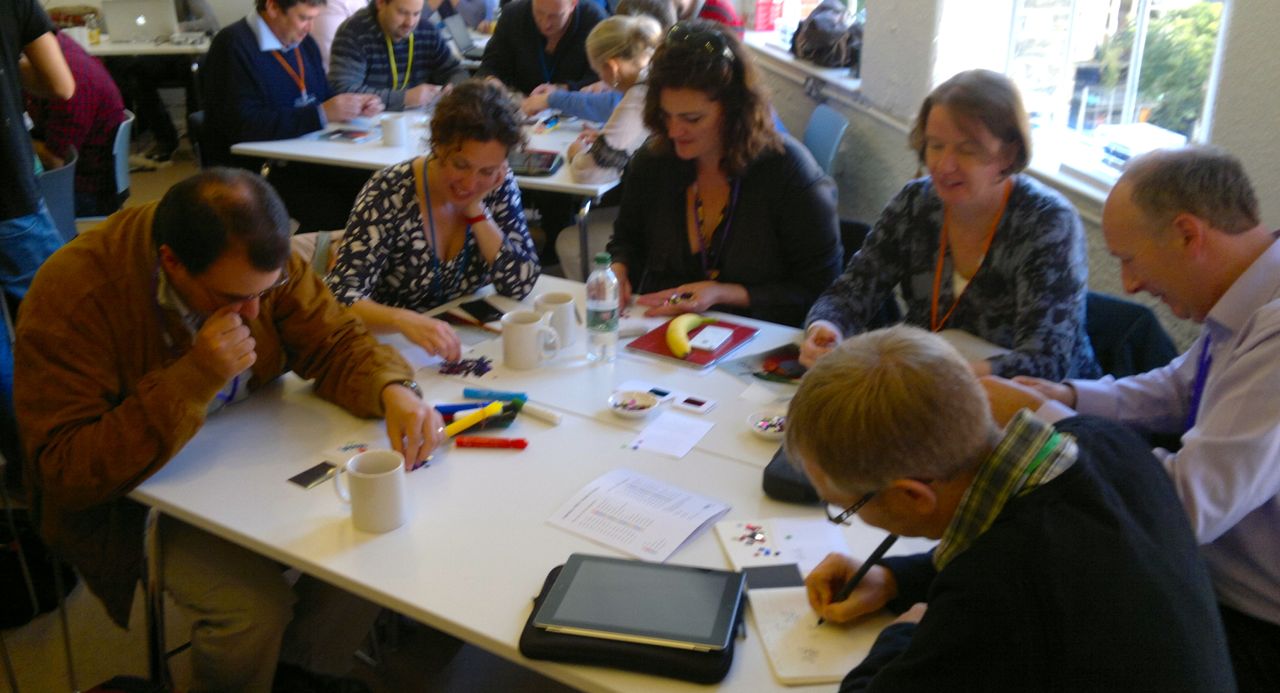
Andrew and Marek introduced an exercise to encourage creative thinking about pixels as the building blocks of visual experience. Working individually or in groups, participants created 6 x 10 grids of pixel art by sticking tiny squares of reflective metallic foil on to mock-up phone screens. The exercise reminded participants of the raw principles behind image composition, attaching an importance to the role of craft skills in shaping the digital world which continued throughout the two days.

As the exercise unfolded, it became apparent a wider plan was in play, with each mock-up phone screen backed by a magnetic strip to enable the composition of a collective image on a large metal canvas installed in the conference room. Just as increased pixel density is multiplying the possibilities of interface design in the virtual sphere, the exercise took individual 6 x 10 art works and combined them to create a larger canvas with a unique quality of its own.
Opening the speaker sessions was Dale Herigstad, Chief Interaction Officer of Possible Worldwide, who brought with him 30 years of experience in film, television and interaction design, including four Emmy Awards. Dale spoke about the importance of spatial design, describing how user experience was enhanced by reflecting the 3 layer mental model customers build in their minds: interaction, surface and content.
He described the content space behind the screen as the domain of brands, with little user control. The surface space or screen allowed user adjustments to visual elements. However, his primary interest was the metaphorical space between user and display surface, where new interactions could be created. In this zone, mobile devices are enabling users to interact with content on their own terms, creating flows of meta in response to popular TV shows and augmenting immersive, full screen applications with small disruptions manifest on mobile displays.
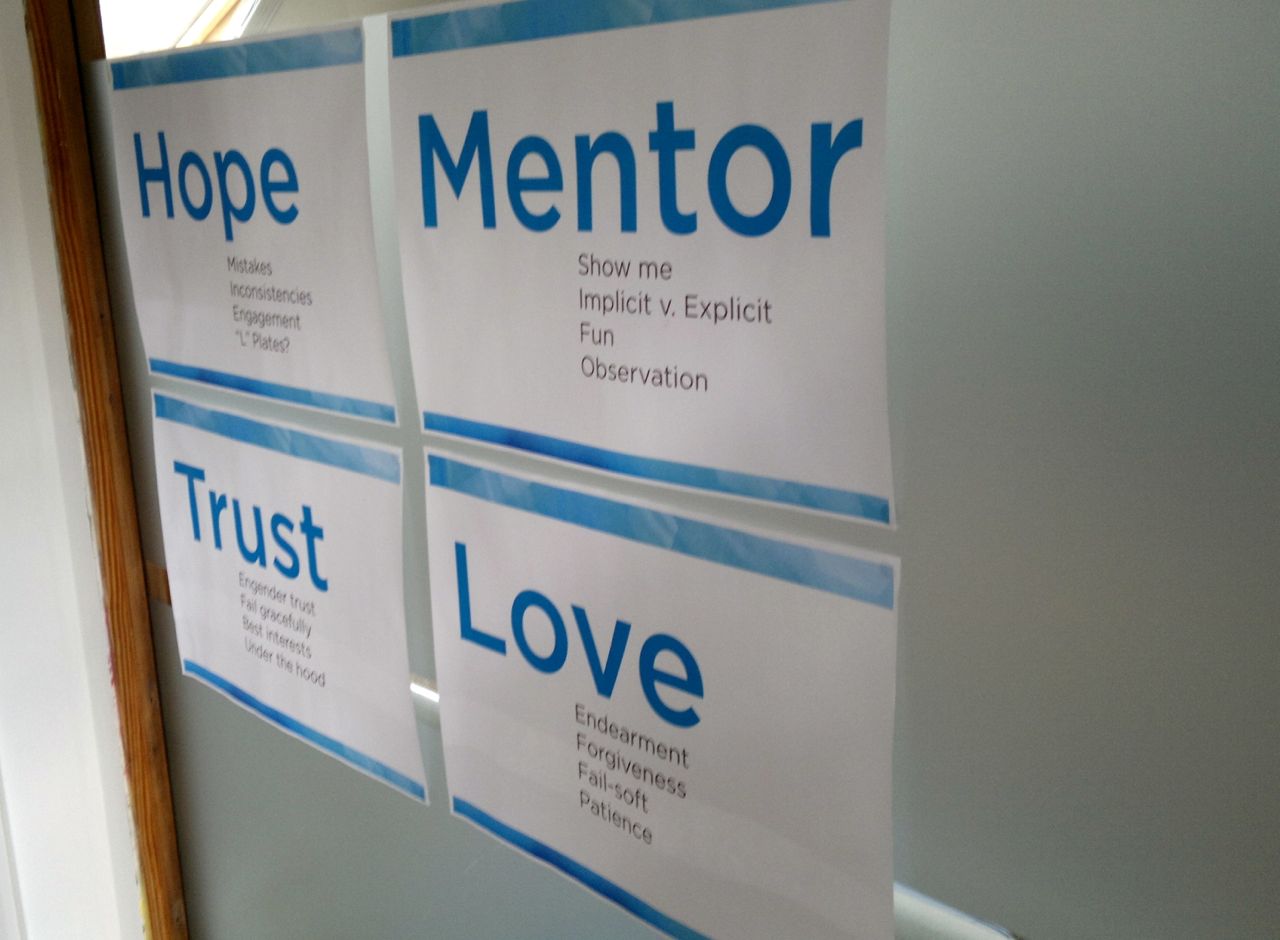
Peter Whale, Director of Product Management at Qualcomm, explored how contextually responsive digital experiences must take human emotional characteristics if they are to succeed. He summarised these as ‘Mentor, Hope, Love and Trust’, referring to how context aware systems should learn, demonstrate their education and work transparently to establish a close bond with users.
The enablers of context aware computing are arriving, with Qualcomm supporting always on sensors and power management at chipset level. However, despite his engineering background, Peter emphasised the importance of looking beyond what might be technically possible and instead addressing more immediate concerns, such as how the failure events inevitable in any new technology could be gracefully managed with minimum impact to user experience.
A dominant theme of MEX is to look for answers beyond the accepted wisdom of the digital industry. The next speakers, Sam Livingstone and Joe Simpson of Car Design Research, were invited specifically to encourage cross-industry learning. Both lecture in vehicle design at the Royal College of Art and work with automotive clients from Audi to Ford.
Their session provided insight on two levels: learning design process from an industry more mature than mobile and exploring the prospects for digital experiences inside and outside the car. Sam Livingstone explained how the automotive industry’s intense focus on style, where it is not unusual to spend more than a year iterating a single section of bodywork, evolved in response to consumers’ disinterest in the basic transportation capability of cars to a world where most of the USD 100bn annual spend on automotive is motivated by emotional luxuries.
Joe Simpson detailed the challenges facing automotive manufacturers as they respond to consumer demand for digital experiences, particularly the distracted in-car interaction environment. He warned against the current trend for car manufacturers to replicate the touch interfaces found on mobile devices, emphasising the cognitive load they placed on users, and identified these control mechanisms as an area where manufacturers could differentiate in the future.
There is an opportunity for those working on augmented reality in mobile devices and digital eyewear to learn from the established principles of traditional automotive control design, where practitioners have been fine tuning non-distracting interfaces for decades.
Following Sam and Joe’s presentation, Andrew and Marek introduced the first of the creative team sessions, one of the key ways in which all participants at MEX shape the collective response. Participants joined 1 of 6 teams, each tasked with a challenge relating to a different Pathway. Teams were led by MEX-appointed facilitators, including Andrew himself and Geoff McCormick, Director of design consultancy Alloy, Kate Ho, Managing Director of agency Interface3, Sophie Arkette, a designer and researcher in audible perception, Peter Andic, a designer at Qualcomm Research Cambridge and James Alexander, Partner at The Foundation.
Also joining each team were two designers from Brunel University, working as part of a long established partnership between MEX and Brunel, where participants contribute their knowledge and visualisation skills to help teams develop their ideas.

The teams each had their own individually designed rooms as a base for the 2 days and, upon arriving for the first session, found their challenge presented as a series of cards detailing the problem. Each team was also equipped with stimuli, ranging from video clips to demo devices.
The first team session saw each group exploring their challenge and experimenting with the stimuli. The challenges varied according to the objectives of each Pathway. In Pathway #3, for instance, the team was asked to develop 5 UI elements suited to simultaneous multi-person interface design, while in Pathway #14, the group worked on principles to govern the development of context aware experiences.
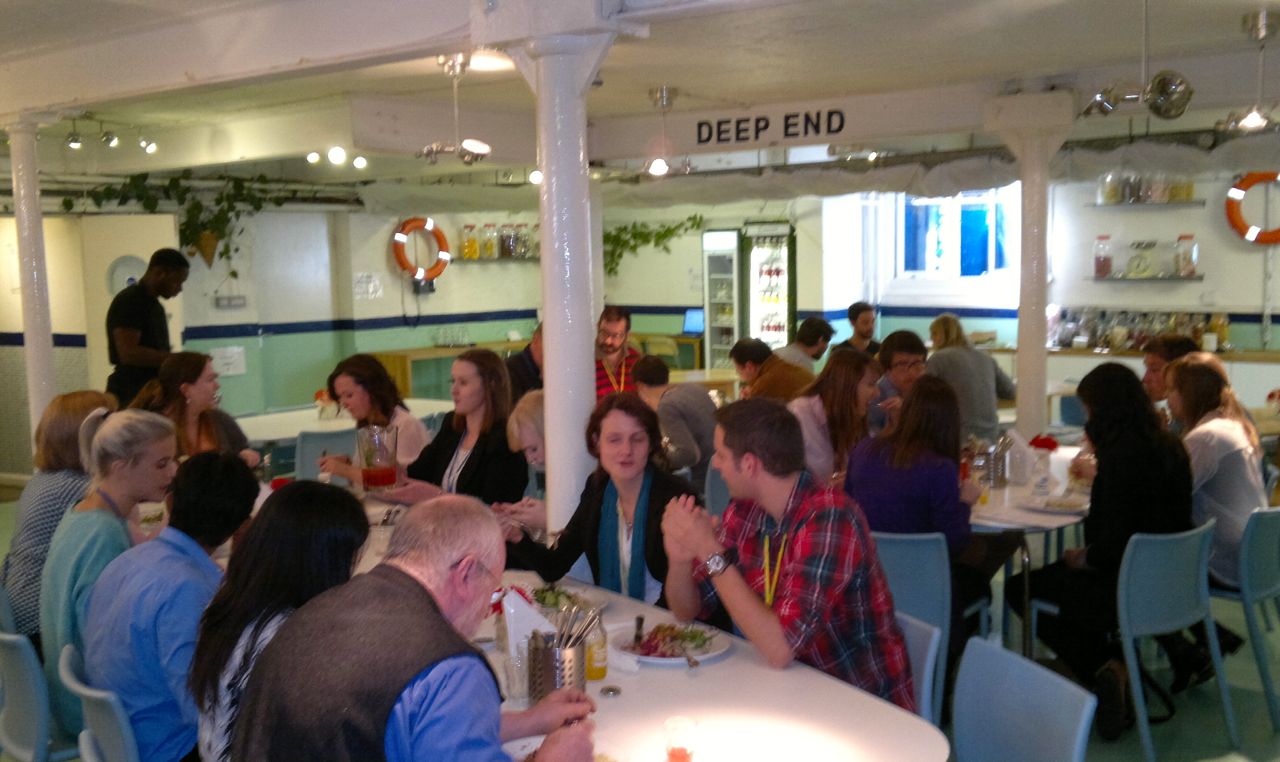
Lunch is a highlight of any MEX, with the Wallacespace chefs cooking seasonal and healthy brain food, served in the collegiate atmosphere of the garden cafe. It is also the point at which MEX participants discover the ‘help yourself’ candy bar and return to the afternoon sessions laden with bowls of their favourite treats.

Kate Ho, Managing Director of Interface3, built on ideas introduced in her 2010 MEX session, when she established the early thinking around simultaneous multi-person interfaces in Pathway #3. Interface3 has made its name as a pioneer in this area, first building SMUIs for large-scale touch devices like Microsoft’s Surface (the coffee table version, not the yet-to-ship tablet announced earlier this year) and more recently in simultaneous multi-person games under its Tiger Face brand.
While gaming is an obvious area for experimentation, Kate also explained the principles learned in this exploration would shape simultaneous interface design in business applications. She articulated her design priorities, ranging from gestures based on real world physics, executable at an extended distance from the device, to interface elements universally accessible to all simultaneous users.
Patrick Bergel, CEO of Chirp, has developed a way for machines to sing data to each other, using principles inspired by birdsong. This elegant concept, relevant to the MEX exploration of non-visual interfaces, is enhanced by Patrick’s commitment to making the virtual, tangible. He explained the importance of manifesting data within the audible range, ensuring users felt a physical understanding of the transfers.
The ability for Chirp to overlay traditional communication is intriguing, with teachers already using it to broadcast links during classroom lectures. The simplicity of its implementation and low cost of equipping devices with Chirp may expedite the growth of machine citizens on networks.
The second creative session of the afternoon saw the teams re-convening to research the specifics of their challenge, including user personas.
Louisa Heinrich, Group Strategy Director at Fjord, combined practical lessons from her agency’s service design projects with a longer term view of how users would react to context aware experiences. She sounded a particular note of caution over the incompatibility of designers’ desire to solve specific problems through context awareness with the unstructured way in which people think about their lives. Designers justify decisions based on answers and facts, but most user decisions are based on lies we tell ourselves to feel better.
She gave the example of how services like Nike Plus and Fitbit are allowing users to see a quantified self and making contextual suggestions to improve their health. However, Nike Plus and Fitbit are unable to understand the subtle nuance which causes humans who haven’t exercised during a stressful week to reject what’s medically best for them – i.e. going out for some exercise in the fresh air – and instead spend the weekend lazing around the house watching films and drinking wine.
She suggested the innate human ability to perform sub-conscious pattern recognition is a latent resource designers can tap to solve this problem, handing greater control over contextual experiences to users with little additional cognitive load.
James Alexander, partner at The Foundation, was tasked with broadening participants’ views on the role of speed in digital experiences. His background includes launching mobile services as the Strategy Director for pioneering internet bank Egg, but his work at The Foundation covers a much wider remit, bringing customer-centred thinking into boardrooms.
He reminded participants speed itself is rarely detectable or understood by users; instead it is actually acceleration which captures user attention. The periods when an experience accelerates or decelerates, therefore, are where perceptions are formed. Similarly, humans have biological latency in their reaction times, making it impossible to respond within less than 100ms of an event. This is used to determine false starts in sprint races, but also provides a timeframe for the window interaction designers have to make an experience feel instantaneous.
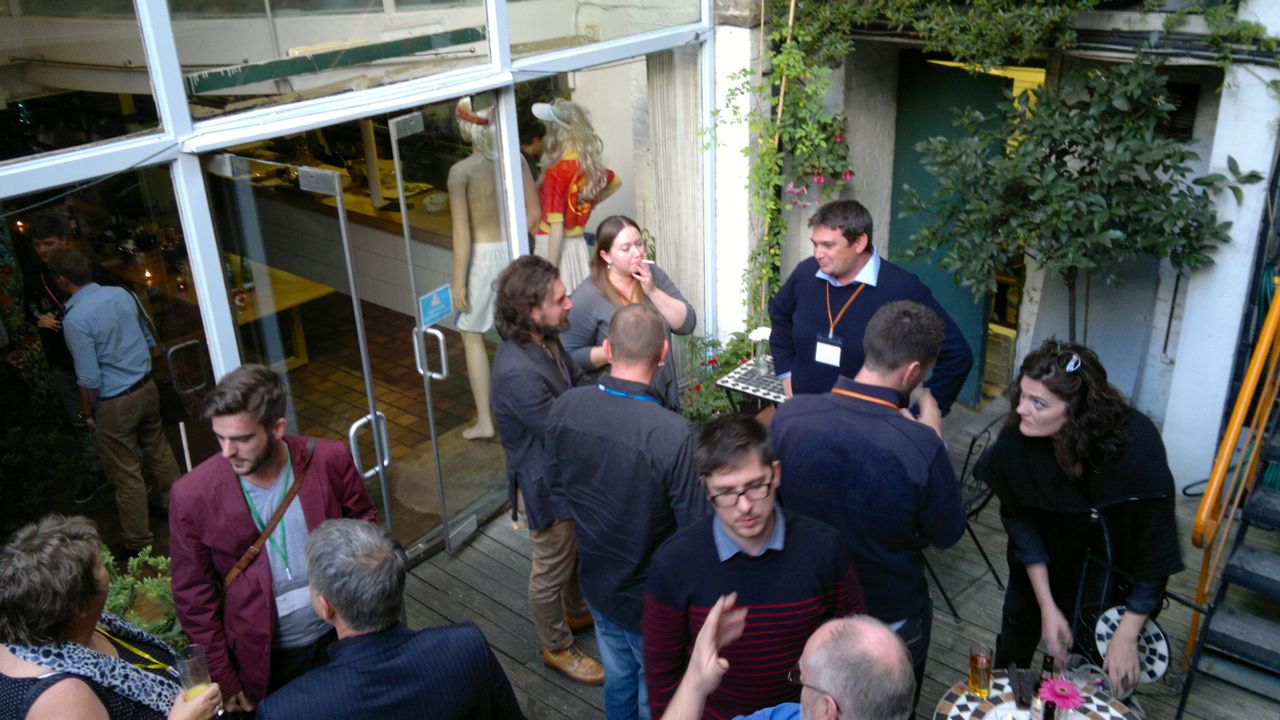
The first day of MEX concluded with an evening reception in the garden cafe, where discussions continued into the night, accompanied by rounds of seasonal canapes provided by the Wallacespace chefs.
The second day opened with Sabrina Majeed sharing insights gained during her work on Miso, a context aware service designed to complement TV viewing. She described different methods they’d tried to understand user context, both in respect to the content they were viewing and their wider situation. It led her to conclude not all contextual data are equal and the experience must reflect the different qualities and reliability of contextual sources.
She prioritised delivering a core UX which impressed users with minimal contextual input, but could be enhanced in a modular way as more contextual information became available.
Ivo Weevers, Head of Design for the Ubuntu OS used by 20 million people worldwide, explained how building digital experiences across mobile, PC, TV and other touchpoints caused them to rethink their design process. It started with centralising the design team, one of the few parts of the company to sit together in a single location, in an organisation widely known for its distributed engineering base.
This enabled them to start mapping user tasks across different touchpoints and developing an understanding of how actions initiated on a mobile might be completed on a PC or TV. In response, they created core features common to each of these platforms, but refined interaction sequences for each touchpoint according to its unique capabilities.
Pathway #9, Sensation, was back in focus with Charlotte Magnusson, Associate Professor in the Department of Design Sciences at Lund University. Charlotte shared specific recommendations from an ongoing project to enhance maps with non-visual interactions. HaptiMap was developed by an EU-wide consortium and took a user-centred approach to understanding how sensations such as touch and hearing augment the experience of mapping on mobile devices.
The project team discovered users responded better to both haptics and sound when they were inspired by natural rhythms, such as a heartbeat or breathing. They also investigated how to overcome the problem of sensory filtering, where high noise environments made this kind of system difficult for the user to process. Crucially, she stressed the role of playfulness in these sensory experiences, citing it as a major factor in their more successful experiments.
The creative teams gathered for their penultimate session just before lunch on the 2nd day, with MEX co-hosts Andrew and Marek reminding participants now was the time to start crystallising the teams’ responses to their challenges. The teams were asked to return after the hour long development time for a creative exchange, where they’d share the approach taken to solving their respective problems and have an opportunity to exchange ideas between Pathway teams before going into their final development session.
The result of this exchange was an understanding that, despite working on distinct problems and scenarios themed around different Pathways, there were complementary strands emerging.
Pathway #2, for instance, on multi-touchpoint experiences was causing the Pathway #3 group exploring simultaneous UIs to think beyond users physically located around a single device and how several devices could share the same conceptual UI canvas. The Pathways on Sensation (#9), Context (#14) and Speed (#16) were emerging as underlying enablers of many digital experiences, with close links between them. #15, on Clarity, was at once both the most practical – what to do today with all the new pixels available on HD displays – but also the most conceptual, considering entirely new services made possible once displays achieved a level of clarity indistinguishable from reality.
The final speaking sessions saw Marcelle von Wendland, Vice President at Fincore, describing the user research behind multi-touchpoint experiences in the financial services industry. It was another example of how MEX looks to other industries, particularly those with extreme use cases, to illuminate a particular Pathway.
Marcelle focused on 3 modes of user behaviour discovered in her research: the campfire, hunting path and crows nest. Each of these behaviours summarised a particular combination of user intent and context, applicable to several different digital touchpoints, allowing them to design experience flows which worked across mobile, tablet and PC. She also identified design priorities specific to sensitive services like finance, placing importance on continuity between touchpoints, anticipation of user needs and constantly re-assuring users.
Nancy Perlman, a design researcher whose work in mobile dates back to the days of the Apple Newton, gave the final speaker session, focusing on social implications of digital technology and the role of simultaneous UIs. After identifying behavioural problems common in children of all backgrounds and the importance of non-cognitive learning in alleviating them, she explored how a different approach to UI design could transform digital devices from immersive, individualistic experiences into something more collegiate.
She left participants to consider how designers could create digital experiences such as those identified in Pathway #3, which prioritised sharing, taking turns and social interactions. Nancy also stressed the importance of human contact in learning, showing examples where lessons could only be learned efficiently through direct human contact, and not taught remotely via digital devices.

The conclusion of MEX saw participants returning to their creative teams to bring together a final response to their respective challenges. Guided by their facilitators and Brunel designers, each team room was a hive of activity as members who met each other just a day before came together with remarkable spirit to rehearse, sketch, construct models and finalise their ideas.

The results of these creative sessions exceeded expectations: showing not only how much newly formed teams can achieve in just two days, but also a consistently high quality of response to their individual challenges. The detailed outcomes will be published in a later report made available to all MEX participants, but suffice to say the final session, when each team presented its findings, combined performance, laughter and insight in equal measure.
MEX is a patient endeavour, ongoing for more than 7 years, and benefits from the extraordinary depth of talent which has grown into a community around the Pathways, research and events. This historical resource is drawn upon constantly, but each new event brings with it a unique set of moments and relationships created by the participants who come together for 2 days to make it happen. This 11th international edition felt particularly successful in defining best practice in mobile user experience and generating entirely new ideas for the future.
It has also left us with intriguing new strands to investigate and continue into Pathways for the 12th MEX, to be held in London on 26th – 27th March 2013. There are opportunities for speakers, sponsors and participants – please join us there.
Thank you to those involved in the ongoing efforts before, during and after the event: the participants, speakers, facilitators and Brunel team. Also, to our sponsors Qualcomm and ICTKTN for having the vision to support this endeavour.

+ There are no comments
Add yours